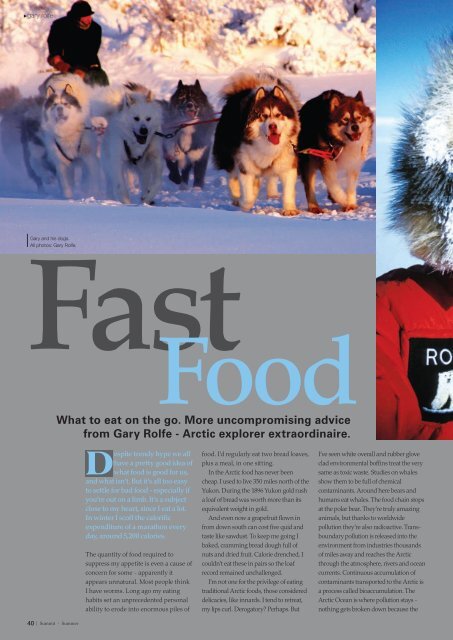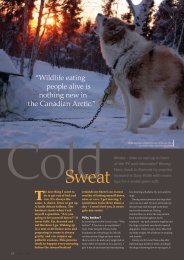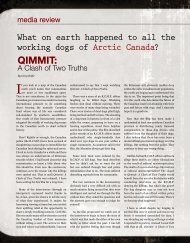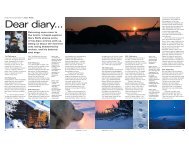Fast - Gary Rolfe
Fast - Gary Rolfe
Fast - Gary Rolfe
Create successful ePaper yourself
Turn your PDF publications into a flip-book with our unique Google optimized e-Paper software.
gary rolfe<br />
<strong>Fast</strong><br />
Food<br />
What to eat on the go. More uncompromising advice<br />
from <strong>Gary</strong> <strong>Rolfe</strong> - Arctic explorer extraordinaire.<br />
<strong>Gary</strong> and his dogs.<br />
All photos: <strong>Gary</strong> <strong>Rolfe</strong>.<br />
Despite trendy hype we all<br />
have a pretty good idea of<br />
what food is good for us,<br />
and what isn’t. But it’s all too easy<br />
to settle for bad food - especially if<br />
you’re out on a limb. It’s a subject<br />
close to my heart, since I eat a lot.<br />
In winter I scoff the calorific<br />
expenditure of a marathon every<br />
day, around 5,200 calories.<br />
The quantity of food required to<br />
suppress my appetite is even a cause of<br />
concern for some - apparently it<br />
appears unnatural. Most people think<br />
I have worms. Long ago my eating<br />
habits set an unprecedented personal<br />
ability to erode into enormous piles of<br />
food. I’d regularly eat two bread loaves,<br />
plus a meal, in one sitting.<br />
In the Arctic food has never been<br />
cheap. I used to live 350 miles north of the<br />
Yukon. During the 1896 Yukon gold rush<br />
a loaf of bread was worth more than its<br />
equivalent weight in gold.<br />
And even now a grapefruit flown in<br />
from down south can cost five quid and<br />
taste like sawdust. To keep me going I<br />
baked, cramming bread dough full of<br />
nuts and dried fruit. Calorie drenched, I<br />
couldn’t eat these in pairs so the loaf<br />
record remained unchallenged.<br />
I’m not one for the privilege of eating<br />
traditional Arctic foods, those considered<br />
delicacies, like innards. I tend to retreat,<br />
my lips curl. Derogatory Perhaps. But<br />
I’ve seen white overall and rubber glove<br />
clad environmental boffins treat the very<br />
same as toxic waste. Studies on whales<br />
show them to be full of chemical<br />
contaminants. Around here bears and<br />
humans eat whales. The food chain stops<br />
at the polar bear. They’re truly amazing<br />
animals, but thanks to worldwide<br />
pollution they’re also radioactive. Transboundary<br />
pollution is released into the<br />
environment from industries thousands<br />
of miles away and reaches the Arctic<br />
through the atmosphere, rivers and ocean<br />
currents. Continuous accumulation of<br />
contaminants transported to the Arctic is<br />
a process called bioaccumulation. The<br />
Arctic Ocean is where pollution stays -<br />
nothing gets broken down because the<br />
40 | Summit - Summer<br />
40-43 food.indd 40 31/5/07 5:15:33 pm
gary rolfe<br />
Saxon carries his own food<br />
in a Ruff Wear dog pack.<br />
“ If all else fails I eat dog food.”<br />
The man himself<br />
- <strong>Gary</strong> <strong>Rolfe</strong>.<br />
Five-month old<br />
Spoons.<br />
sun can’t get at it under the sea ice.<br />
I now live in Greenland, a country<br />
known for its pristine wilderness but<br />
pollution from lower latitudes is a<br />
growing concern. The major threat for<br />
human health is mercury. Mercury is<br />
concentrated in the food chain and<br />
reaches high levels in the traditional<br />
Greenlandic diet, mostly marine<br />
mammals. Extremely high levels of<br />
mercury have been found in the blood<br />
of hunters and their families from<br />
Greenland. Women now breast-feed<br />
their kids with contaminated milk.<br />
I meanwhile filter all my water with<br />
a First Need purifier. I’m never<br />
without water in an Aztec steel<br />
vacuum flask. Filled with boiling<br />
water and left outside for three days<br />
at minus forty, the contents will<br />
remain brew warm. Wrapped around<br />
a steel flask I’ve a magazine sized<br />
piece of Multimat’s EVA foam, big<br />
enough to sit, stand or kneel on. This<br />
I tab with a Velcro clasp. In summer<br />
day trips I like the Aztec Widemouth<br />
1.2 litre steel flask for keeping a<br />
decent meal piping hot.<br />
In the western Arctic beluga whale<br />
hunters do their stuff in August. None of<br />
your old fashioned approach in nimble<br />
kayak armed with twig like harpoon<br />
scenes now. It’s all satellite phones, highpowered<br />
rifles then back home to the<br />
VCR. Though be warned. If the pollution<br />
doesn’t ruin your spoils, poor food<br />
handling might. Someone always dies<br />
from botulism caused by eating muktuk<br />
(raw whale fat) that’s been summerstored<br />
in sweaty sealed plastic buckets.<br />
One way I overcame crippling food costs<br />
(and botulism) was to cross time zones<br />
and drive south 2,800 miles to Edmonton<br />
in Alberta. The plan was simple: spend a<br />
week shopping then head north with it<br />
all. My crazily long list always included<br />
40lb of dehydrated banana chips, 70lb of<br />
dried fruit, 12lb of dried milk and 4 tons<br />
of Nutrience dog food.<br />
A month’s expedition food takes a full<br />
day to pack. I always do this alone. Food<br />
lists take into account safety margin and<br />
rest days. I’ve still got pre-laptop lists<br />
noting spoon and cup counts tallying<br />
Summit - Summer | 41<br />
40-43 food.indd 41 31/5/07 5:16:28 pm
gary rolfe<br />
“ There’s no point scrimping<br />
in the cold - planned<br />
starvation isn’t clever”<br />
During a 400-mile summer journey made<br />
on foot with two dogs in Nunavut (Canadian<br />
Arctic) <strong>Gary</strong> had six grizzly bear encounters.<br />
Here he eats away from his tent.<br />
60-litre Harcostar<br />
re-supply drums.<br />
everything that I eat. Fascinating stuff<br />
like 118 spoonfuls make up a 340g pot of<br />
instant coffee. It’s a laborious process<br />
because I’m hopeless at sums. And I<br />
mean hopeless, I always made myself<br />
treble-check the count with a calculator.<br />
These days it’s easier - everything now<br />
goes on to neat Panasonic Toughbook<br />
spreadsheets that add up for me.<br />
A pound of butter I cut into quarters.<br />
This lasts a bad week, one of insane<br />
calorific output. With a knife, frozen<br />
butter sticks are easier to whittle and add<br />
to food. Calculated amounts of dried<br />
fruit is mixed into rolled oats. Not just<br />
raisins and sultanas but dried<br />
strawberries and pineapple. There’s no<br />
point scrimping in the cold - planned<br />
starvation isn’t clever. Prepared<br />
perishables like cheese I leave outside,<br />
protected from my dogs and wolf packs,<br />
to freeze before giving it the chance of<br />
going hairy. The preparation is<br />
pernickety, but in a tent I want nutritious<br />
Caught under the Mackenzie River ice,<br />
<strong>Gary</strong> boils his fish to kill a nasty strain<br />
of parasitic worm unique to this<br />
region of the Northwest Territories.<br />
40-43 food.indd 42 31/5/07 5:17:15 pm
gary rolfe<br />
“ The food chain stops at the polar<br />
bear. They’re truly amazing animals,<br />
but thanks to worldwide pollution<br />
they’re also radioactive”<br />
and satisfying food then sleep. The less<br />
time it takes from bag, to pot, to mouth<br />
the better.<br />
Most dried grub sold as ‘expedition<br />
food’ is nasty. If you’re serious about what<br />
you eat there’s no trusting what goes into<br />
this stuff. Look at the ingredients on<br />
‘expedition food’ packaging. You can do a<br />
better job and save money; you can<br />
determine what goes into your meals<br />
without those health-tampering additives.<br />
I love meat, and drying caribou, musk<br />
ox or fish in the Arctic is easy - the<br />
perpetual summer sun allows it. Framed<br />
bug-proof netted boxes looking like bird<br />
aviaries allow air to pass freely, and thin<br />
strips can make good tasting jerky in<br />
hours. It’s not easy to do in the UK<br />
though - you’ll need to head into the<br />
kitchen. To dehydrate meat in an oven<br />
grind it up. Beef is best, once dry it’ll<br />
become powder-like. Alternatively cut the<br />
meat into thin strips to make jerky. It’s<br />
light and nutrient-dense. You can get<br />
delicious, tender, high-protein jerky from<br />
even cheap meats, and it stores<br />
indefinitely. Fish also tastes good<br />
preserved this way too. The only trouble<br />
with ovens is that they cost a bit to run,<br />
and you have to constantly flip and rotate<br />
the load - a bind.<br />
If you like the sound of drying your<br />
own food then you’ll need a food<br />
dehydrator - I use Excalibur ones. These<br />
come small or as big as you want.<br />
Purpose made driers house the food on<br />
screen trays. A fan in the unit’s base<br />
circulates air through and out at a<br />
regulated temperature. Dehydrating fruit<br />
is simple. Wash, cut and trim bruises<br />
before placing on a drying tray. Using<br />
frozen fruit to dry is good because it’s<br />
already prepared, no stalks or peel to<br />
mess with. Dried fruit can be eaten at<br />
once. When preparing menus it’s<br />
important to remember that vegetables<br />
re-hydrate at different rates. The fresh-todry<br />
times for all fruit and vegetables vary<br />
too. With practice it’s really easy to create<br />
what you know to be healthy.<br />
Forget trans-Atlantic flights with<br />
copious amounts of food though.<br />
Chances are that killjoy customs officials<br />
will stop you with it and spoil your plans.<br />
If you can’t dry your own food US food<br />
companies like Justtomatoes Etc. offer a<br />
magnificent array of unadulterated<br />
dehydrated fruit and vegetables, so go<br />
with time to buy and prepare in Canada<br />
or the US. Summer food preparation<br />
differs from winter considerations. If<br />
you’re flying north (above the Arctic<br />
Circle) then airline cargo expeditors can<br />
keep foodstuffs frozen or warm year<br />
round during flights. There’s a Canadian<br />
post office service called Food Mail. Buy<br />
provisions at allocated stores and<br />
groceries can be shifted around the Arctic<br />
at a cheap rate.<br />
Summer food cache depots flown out<br />
ahead of me contain vacuum packed<br />
food. Re-sealable bags don’t hold content<br />
odours and advertise free grub for four<br />
legged gluttons like bears, wolves or<br />
wolverines. Vacuum packers are cheap<br />
enough. Food expected to withstand a<br />
Cessna 185 floatplane flight better be<br />
waterproof too. All my re-supplies are<br />
packed to survive rough and tumble<br />
travel. Bears bust padlocks so I thread<br />
and twist brass snare wire through barrel<br />
lids to secure them. I use Harcostar<br />
Drums - they’re light, tough and reliable<br />
30 to 220 litre plastic drums.<br />
Nobody grows stuff in the ground up<br />
north. Dirt is frozen solid year round.<br />
When training or preparing a journey<br />
from a warm base camp I sprout things<br />
like peas, mung beans, red clover, alfalfa<br />
and canola. I cover a jar bottom or<br />
shallow tray with seeds, soak for a few<br />
hours to swell and drain before covering<br />
the container with mosquito netting.<br />
Twice daily I add cold water, swirl and<br />
drain. Most seeds sprout within a couple<br />
of days. Mumm’s Sprouting Seeds<br />
guarantee me fresh essential minerals<br />
and vitamins. In the dead of winter I<br />
grow them indoors. Though colourless<br />
they’re nutritious and taste great. I started<br />
sprouting seeds after reading about Arctic<br />
explorer William Parry. In 1819 Parry was<br />
chosen by the Admiralty to explore the<br />
Arctic for the Northwest Passage. Beset in<br />
winter sea ice he grew cress and mustard<br />
seeds by the light of his ship’s candles.<br />
Supplemented with preserved berries<br />
and lemon juice he staved off scurvy from<br />
his crew.<br />
Food isn’t much good without a stove.<br />
Throughout Arctic summers MSR XGK<br />
EX stoves keep me fed and watered.<br />
<strong>Gary</strong> and his dogs camped, resting and well fed<br />
- Amundsen Gulf, Northwest Passage.<br />
“ I’m not one for the<br />
privilege of eating<br />
traditional Arctic foods,<br />
those considered<br />
delicacies, like innards. I<br />
tend to retreat, my lips curl.”<br />
Some things can be improvised on the<br />
Arctic Ocean. A stove can’t. In dreadful<br />
minus 50Cº cold my stove repeatedly<br />
melts 90 litres of snow and boils 12 litres<br />
of water to hydrate my dogs and myself. I<br />
pack more than matches in the shape of<br />
an Ultimate Survival Strike Force allweather<br />
fire starter. It’s a fail-safe stove<br />
ignition method. The Blast Match version<br />
is operational with one hand.<br />
If all else fails I eat dog food. It’s fit for<br />
human consumption. ■<br />
More information<br />
www.garyrolfe.com <strong>Gary</strong> <strong>Rolfe</strong>’s site<br />
www.ukjuicers.com Food dehydrators<br />
www.lakeland.co.uk Vacuum food sealers<br />
www.justtomatoes.com Dehydrated fruit and vegetables<br />
www.harcostar.co.uk 30 to 220 litre plastic drums<br />
Summit - Summer | 43<br />
40-43 food.indd 43 31/5/07 5:17:53 pm





